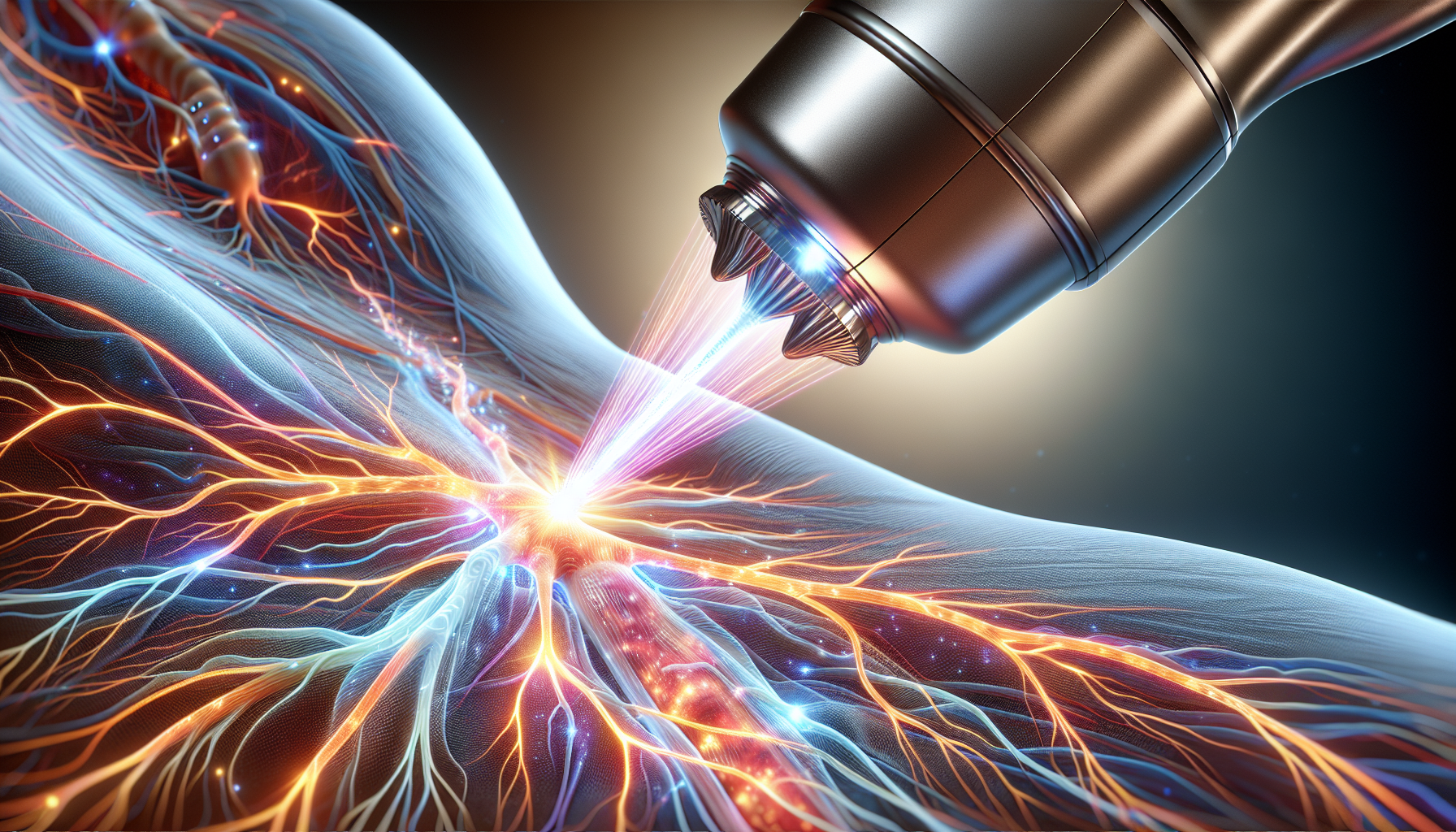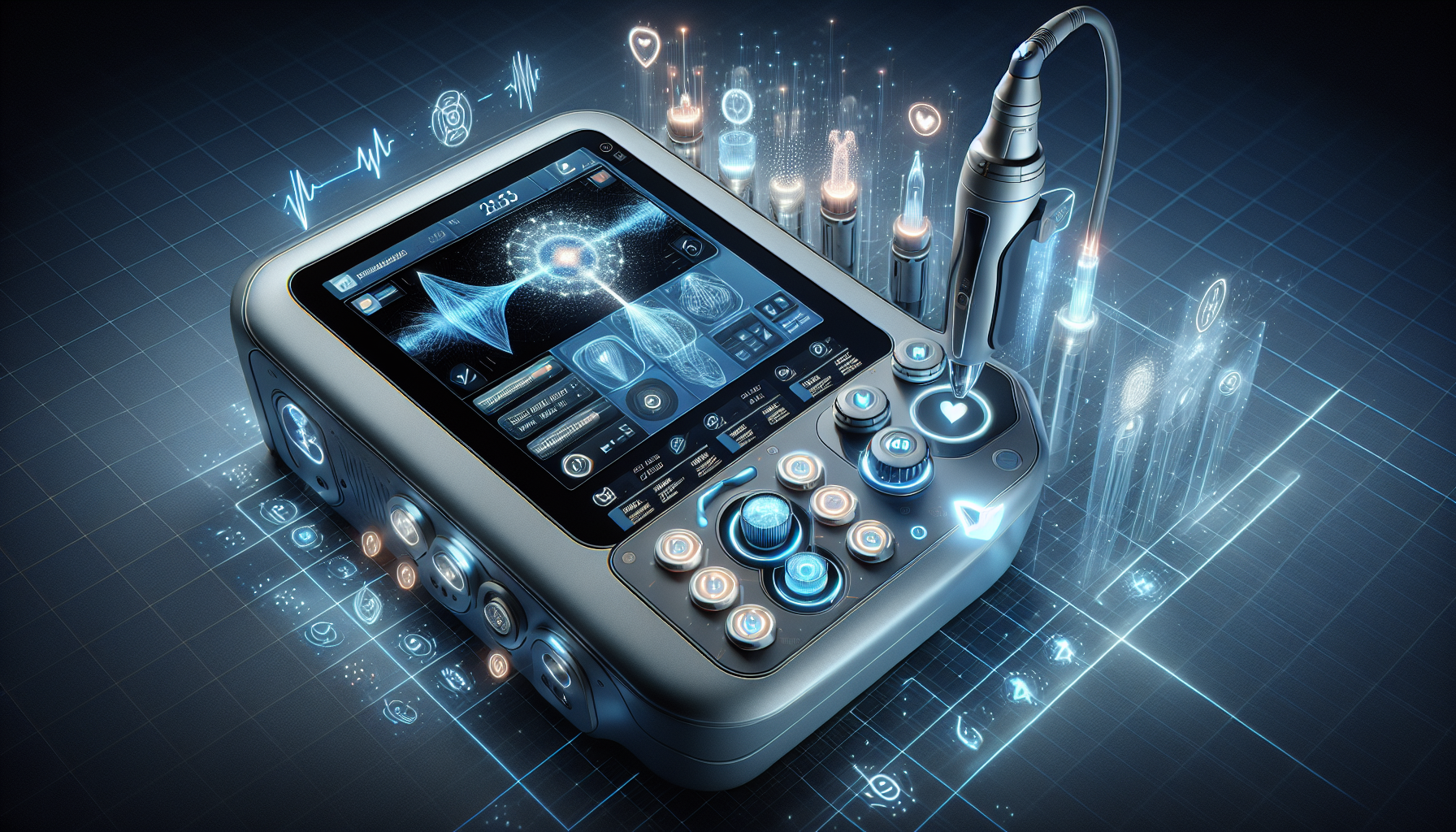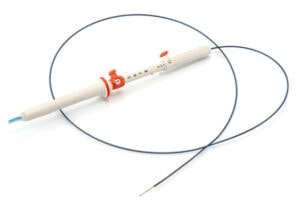RFA Treatment Radio Frequency Ablation Device in Canada
RF ablation equipment is vital for treating chronic pain via minimally invasive techniques. RFA technology advancements have led to the development of the Vivo RFA generator.
Explore the Vivo Generator RF ablation device, it’s components, applications, and innovations. Whether you’re a clinician or patient, discover how RF ablation technology can offer fast and effective pain relief.
Key Takeaways
-
Instrumed Surgical is a leading provider of radiofrequency ablation (RFA) devices in North America, specializing in advanced pain management technologies that target chronic pain using thermal energy precision and minimally invasive procedures.
-
RF ablation technology utilizes radiofrequency energy to disrupt pain transmission pathways, making it a minimally invasive and effective treatment for various chronic pain conditions like back, neck, and facet joint pain.
-
Modern RF ablation systems integrate advanced features such as temperature monitoring, real-time tissue impedance monitoring, and adjustable power settings, enhancing procedure precision, safety, and customization.
Instrumed Surgical provides RFA devices in Canada and the United States

Instrumed Surgical, is the distributor of choice for RFA devices for the field of pain management. They providing cutting-edge radiofrequency ablation (RFA) devices in Canada and the United States. Utilizing the precision of thermal energy, Instrumed Surgical’s Vivo Generator targets the problematic nerves responsible for transmitting intense signals of pain. This treatment; goes to the root of the cause where the chronic discomfort emanates from.
Pain therapy made hedge advances when, in the 1970s, the use of radiofrequency emerged as a beacon of hope for those afflicted with intractable pain. Since then, RFA treatment has grown in popularity with clinicians, due to its minimally invasive nature and its ability in reducing chronic pain syndromes including:
-
back pain
-
neck pain
-
facet joint pain
-
radicular pain
Instrumed Surgical provides 3 separate Radio Frequency ablation treatment systems (RFA Treatments).
RFA devices like the Vivo Generator are not just tools; they are key in reducing severe pain which would otherwise prevent many patients from working and living a happy productive life.
Overview of RF Ablation Technology

The essence of radiofrequency ablation technology is its ability to conduct a radiofrequency energy, precisely targeting the nerves that serve as conduits for pain signals to the brain. By generating heat through radio waves, RFA disrupts these pathways, offering up to 6 to 12 months of reduction in chronic pain. The RFA treatment provides the clinician with a procedure that destroys the problematic nerve endings without destruction of other critical structures in the procedure location.
Since its first mention in literature during the 1970s, RFA has flourished, evolving into a cornerstone of pain management. Its growth is fueled by the promise of a minimally invasive approach that spares patients more invasive surgical procedures and addictive pain management medications. RFA treatment can provide relief for those patients suffering from back, neck or facet joint pain.
Key Components of RF Ablation Equipment
The core components of the RFA system, each play a pivotal role in the creation of pain relief. The main component is the electrosurgical generator, the source of the electrical current that fuels the tissue ablation. Electrodes, serving as the conduits for this current, are strategically placed near the afflicted nerve endings to deliver the RF energy directly to the problematic tissue.
Patient safety is ensured by use of a grounding pad which, completes the electrical circuit while protecting the patient from unintended burns. A peristaltic pump in the generator provides, cooling for the active electrode, ensuring the procedure’s efficacy and safety. Together these components provide a level of patient saftey during the procedure.
Types of RF Ablation Devices
A range of RF ablation devices are available, each type tailored to the specific needs of energy delivery and clinical scenarios. RFA devices can include thermal RFA, cooled RF systems, and pulsed RF devices, each with a unique approach to obliterating pain. These specialized RFA systems provide a range of devices that can provide intense heat of thermal ablation to the sophisticated water-cooled systems, all the way to the precision of bipolar devices.
This variety ensures that physicians are equipped with the right tools to tailor treatments to the individual patients pain, based on a review of available options.
Standard RF Ablation Devices
Standard RFA equipment leads the pack of RF ablation devices, the stalwarts of the field. Employing unipolar energy delivery, these devices are the trusted companions in a plethora of medical procedures. One such heralded device is the Barrx Flex energy generator, a paragon of GI tract mucosal ablation, boasting ports for foot switch and output cable connections, a testament to its functional versatility.
From the Barrx Channel RFA endoscopic catheter, threading its way through the scopes to target lesions with precision, to the Habib EUS-RFA catheter, a slender warrior at 190 cm long and 1F in diameter, each device is meticulously designed. The Barrx 360 Express RFA balloon catheter stands out with its self-adjusting balloon, molding itself to the patient’s esophageal anatomy at the distal end, streamlining the procedure and shortening the battle against time.
Cooled RF Ablation Systems

Cooled RF ablation systems are the refined members of the RF device family, utilizing advanced cooling technology to mitigate the risk of collateral damage while creating more extensive pain issues. Within these systems, water or saline circulates to cool the applicator, a strategy that enables the creation of larger, deeper lesions, expanding the therapeutic reach. It’s a delicate balance of applying thermal energy while preserving the surrounding tissues.
These systems are not only adept at treating larger areas of knee pain but also provide variable sources of innervation, such as the enigmatic sacroiliac joint dysfunction. The water-cooled electrode is the linchpin in this process, fostering the growth of larger lesions that promise enduring pain relief.
Bipolar RF Ablation Devices
Bipolar RF ablation devices serve as the precision toolmakers within the RFA family, offering meticulous control over the delivery of thermal energy. By employing two electrodes, these devices create a circuit of high specificity, ensuring that only the intended tissues are destructed. The intermittent bursts of energy they emit help, modulate pain signals without inflicting undue harm.
RFA devices provide a targeted strategy, ideal for procedures that require pinpoint accuracy and minimal collateral impact. With bipolar RFA, physicians can navigate complex anatomical landscapes of the human body, eradicating pain from its roots while preserving the integrity of the surrounding tissues.
Applications in Pain Management
The scope of pain management is extensive, with varied terrain that spans from the chronic aches of long-term conditions to the acute stings of injury. Radiofrequency ablation has proven its effectiveness across these fronts, targeting and disrupting the nerve signals that perpetuate chronic pain, often without the need for general anesthesia.
Whether it’s the small medial branch nerves causing pain from the facet joints or the broader canvases of the cervical and lumbar regions, RFA treatment can provide relief in many cases.
Chronic Pain Treatment
Many lives are effected with acute nerve pain, this pain can be moderate or crippling in nature. When medication and physical therapy fall short, RFA becomes a great low risk procedure which can provide patients with long-lasting pain relief.
Patients who undergo RFA for chronic pain frequently report a significant reduction in pain, which can last for several months. This relief often leads to an improved quality of life and a marked decrease in dependence on pain medications. For many, RFA is not just a treatment; it’s a turning point, a return to a life unencumbered by the constant burden of pain.
Osteoarthritis Knee Pain
Knee pain, a frequent affliction among the elderly, often originates from the wear and tear of osteoarthritis. Cooled RF ablation (CRFA) has emerged as a stalwart ally in this struggle, its ultrasound guidance ensuring that the genicular nerves responsible for transmitting pain are precisely targeted. By positioning the internally cooled probes near these nerves, CRFA offers a reprieve from the relentless discomfort of osteoarthritis knee pain.
Research corroborates the effectiveness of this technique, indicating not only satisfactory pain relief but also functional improvement for those afflicted by knee osteoarthritis. The relief provided by CRFA is not a fleeting moment of relief but a sustained, with pain relief maintained for up to six months post-procedure. For many, this operation is akin to a renewal, a chance to reclaim the joy of movement without pain.
Spinal Pain Management
The spine, a structural cornerstone of the human body, is not immune to the ravages of pain. RFA has been clinically proven in managing chronic back and neck pain, targeting the nerves that snake through the cervical and lumbar regions with strategic precision. This minimally invasive procedure, performed with the guidance of needles and imaging, ensures that the RF energy is delivered with pinpoint accuracy to the afflicted areas.
Different conditions call for different strategies, and RFA adapts with ease. Facet RFA targets the facet joints, often the culprits of pain due to arthritis or injury, while water-cooled RF (WCRF) is used for pain instances with a more elusive source, such as sacroiliac joint dysfunction.
In spinal pain management, RFA stands as a versatile and dependable procedure, leading to reduced pain and restoring the spine’s integrity.
Advanced Features of Modern RF Ablation Systems

As we progress, modern RF ablation systems continue to advance, now boasting advanced features that increased success in more complicated pain therapy situations. These systems are equipped with:
-
Temperature monitoring
-
Mapping software
-
Intelligent algorithms
-
Catheter technology
These advancements together enhance the precision and safety of procedures make RFA a easy choice when considering pain option treatments for patients. These innovations are not just about technical ability; they represent a deeper understanding of the human body and a commitment to patient-centric care.
Intuitive User Interface
The intuitive user interface of modern RF ablation systems acts as a user-friendly hub. Touchscreen interfaces allow physicians to navigate the complexities of RFA with the ease. These advanced interfaces are not just about slick visuals; they offer customizable settings that adapt to the unique demands of each procedure and each doctors personal preference, enabling unparalleled control and flexibility.
Physicians can tailor their interaction with the system, adjusting settings to match their preferences and procedural needs. The Vivo RFA balloon catheter exemplifies this integration, its automated inflation aligning with the patient’s unique esophageal anatomy, a testament to the system’s ingenuity.
Real-Time Tissue Impedance Monitoring
Real-time tissue impedance monitoring feature is a standout asset of modern RF ablation systems, an innovation that acts as the physician’s eyes during the ablation process. The Vivo energy generator, for instance, measures tissue impedance, ensuring each maneuver is guided with precision. This monitoring is crucial, as it correlates with the extent of tissue heating and destruction, providing a real-time map of the therapeutic area.
When the terrain of tissue changes, real-time impedance monitoring responds, alerting the physician to effective lesion formation or the need to adjust tactics to prevent overheating. This feedback mechanism is akin to a conversation between the device and the tissue, where each response informs the next move, ensuring that the ablation parameters are tailored to achieve optimal destruction while safeguarding the patient’s well-being.

Adjustable Power Settings
Modern RF ablation systems resemble precision-engineered instruments, their adjustable power settings offering the physician a variety of options to harness energy delivery with patient anatomy and soft tissue ablation properties. This ability to adjust power allows for a bespoke ablation process, where the unique characteristics of each patient’s tissue landscape are not just considered but paramount. It’s a personalized approach to care that stands at the core of RFA’s philosophy.
Ablation, adaptive impedance control is the strategist, adjusting energy output in real-time as the tissue landscape shifts during the procedure. This ensures that the energy delivery is not just a blanket bombardment but a targeted strike, calibrated to maximize efficacy while minimizing collateral damage to adjacent tissue. Adjustable power settings empower physicians to wield the RF energy with both might and mindfulness, a balance that is the hallmark of modern medicine.
Safety and Efficacy of RF Ablation
Safety and efficacy are a priority in medical interventions, and RF ablation achieves this standard. With its ability to create predictable thermal lesions and selectively target nerves responsible for pain transmission, RFA has established itself as a trustworthy ally in pain management.
The technology not only interrupts the barrage of pain impulses but does so with a finesse that minimizes unintended consequences, reaffirming its role as an effective and safe harbinger of pain relief.
Common Adverse Effects
Even the most advanced medical procedures carry their own risks, and RF ablation is no exception. Patients may encounter a spectrum of adverse effects, including:
-
Hemorrhage
-
Hoarseness
-
Skin burns
-
Cough
-
Sympathetic nerve injury
However, these adversities are not not common, occurring at low rates but acknowledged with transparency.
The landscape of RFA treatment is one of continuous vigilance, where every potential complication is monitored with the utmost scrutiny. While the possibility of adverse effects exists, the incidence is low, a testament to the advances in technique and technology that prioritize patient safety above all else. It is this commitment to minimizing risk that fortifies the trust in RFA as a treatment modality for those seeking solace from the clutches of chronic pain.
Long-Term Outcomes
A treatment’s value is often determined by its long-term outcomes, and in this area, RF ablation provides long lasting relief. When compared to microwave ablation for the treatment of benign thyroid nodules, RFA emerges with a higher volume reduction ratio at both 6 and 12 months follow-up, showcasing its sustained efficacy. Moreover, the absence of significant differences in symptom scores over the long term between RFA and MWA underscores the treatment’s steadfastness.
Patients and physicians alike seek not just immediate relief but a lasting relief from pain. RFA provides outcomes that stand the test of time, affirming its role as a reliable and effective tool in the management of chronic pain conditions.
Financial Considerations
The quest for pain relief often intertwines with financial concerns, and RF ablation is no stranger to this reality. The coding landscape for RFA procedures is navigated using CPT codes, such as 64633 and 64635 for cervical/thoracic and lumbar/sacral facet joint destruction, respectively. Add-on codes, like 64634 and 64636, are utilized for additional procedures performed on the same day, offering a semblance of clarity in the often murky waters of medical billing.
However, the insurance coverage is not always easily attainable, with insurers requiring a detailed map of medical necessity. It falls upon the shoulders of physicians and patients to provide sufficient documentation, ensuring that the financial path to pain relief is as smooth as the clinical one. In this respect, RFA is like any other medical intervention, where the benefits of treatment must be weighed against the economic realities of its procurement.
Areas for Future Research
Positioned at the edge of medical innovation, radiofrequency ablation is set to explore new frontiers in research. Emerging ablation technologies, such as pulsed field ablation, beckon with the promise of further advancements, potentially revolutionizing the way RFA is applied and understood. Nonthermal methods like cryo-balloon ablation also loom as intriguing prospects, inviting a deeper dive into the possibilities they hold for the future of pain management.
Instrumed Surgical provides RFA treatment devices to clinicians in the United States and Canada. To find out more please contact one of our trained sales staff.
Currently available RFA devices are:
Summary
As our journey through the landscape of radiofrequency ablation comes to a close, we reflect on the profound impact this technology has on the lives of those battling chronic pain. From the offerings of Instrumed Surgical to the advanced features of modern RF ablation systems, we have traversed a path of innovation and hope. The safety and efficacy of RFA, underscored by its ability to alleviate pain and improve quality of life, stand as a testament to the relentless pursuit of medical advancement.
Let this exploration serve not just as a repository of knowledge but as a source of inspiration for those seeking relief from pain and for the medical community dedicated to providing it. The future of RFA shines bright with promise, its potential only beginning to be tapped. May the insights gleaned here ignite a spark of curiosity and a flame of resolve to continue pushing the boundaries of what is possible in pain management.
Frequently Asked Questions
What types of pain conditions can radiofrequency ablation treat?
Radiofrequency ablation can treat a variety of chronic pain conditions, such as back and neck pain, facet joint pain, radicular pain, osteoarthritis knee pain, and pain from nerve damage. It’s a versatile treatment option.
How long does pain relief from RFA last?
Pain relief from RFA can last several months, with some patients experiencing significant reduction for up to six months or longer.
Are there any risks associated with RFA?
Yes, there are some potential risks associated with RFA, such as hemorrhage, hoarseness, skin burn, cough, and sympathetic nerve injury, although they occur at relatively low rates. It’s important to discuss these risks with your healthcare provider.
Does insurance cover RFA procedures?
It’s crucial to consult your insurance provider and healthcare team to understand if RFA procedures are covered by your insurance, as coverage depends on sufficient documentation of medical necessity.
What advancements in RFA technology can we expect in the future?
In the future, advancements in RFA technology may include new ablation methods like pulsed field ablation and nonthermal techniques like cryo-balloon ablation, as well as further research into treating various arrhythmias and pain conditions.
